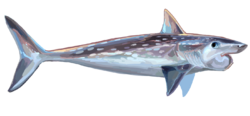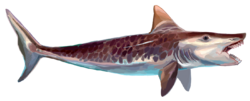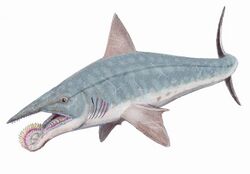Biology:Eugeneodontida
| Eugeneodontida | |
|---|---|

| |
| Helicoprion davisii | |

| |
| Edestus heinrichi | |
| Scientific classification | |
| Domain: | Eukaryota |
| Kingdom: | Animalia |
| Phylum: | Chordata |
| Class: | Chondrichthyes |
| Subclass: | Holocephali |
| Order: | †Eugeneodontida Zangerl, 1981 |
| Synonyms | |
| |
The Eugeneodontida, sometimes also called Eugeneodontiformes, is an extinct and poorly known order of cartilaginous fishes. They possessed "tooth-whorls" on the symphysis of either the lower or both jaws and pectoral fins supported by long radials. They probably lacked pelvic fins and anal fins.[3] The palatoquadrate was either fused to the skull or reduced. Now determined to be within the Holocephali, their closest living relatives are ratfish.[4] The eugeneodonts are named after paleontologist Eugene S. Richardson, Jr.[5] The Eugeneodontida disappeared in the Early Triassic.[6] The geologically youngest fossils of the group are known from the Sulphur Mountain Formation (western Canada), Vardebukta Formation (Svalbard, Norway) and Wordie Creek Formation (Greenland).
Members of the Eugeneodontida are further classified into different families, the most well-preserved members that have been discovered are commonly placed within the families Helicoprionidae ("spiral saws"), and Edestidae ("those which devour"), the former containing the genera Helicoprion, Sarcoprion, and Parahelicoprion, and the latter containing the genera Edestus, Lestrodus, and Metaxyacanthus. All eugeneodonts are thought to have been obligate carnivores, with each genus having specialized feeding behaviors, territory ranges, and specific prey.
Among the eugeneodonts, some members of the superfamily Edestoidea are probably the largest animals of their time during the Late Carboniferous, with Edestus reaching about or exceeding 6.7 metres (22 ft) in length,[7][8] and with Helicoprion measuring over 7.6 metres (25 ft) long.[9]
Taxonomy
The list below shows taxa included within Eugeneodontida.[10]
- Superfamily Caseodontoidea
- Family Caseodontidae
- Genus Caseodus
- Genus Erikodus
- Genus Fadenia
- Genus Ornithoprion
- Genus Pirodus
- Genus Romerodus
- Family Eugeneodontidae
- Genus Bobbodus
- Genus Eugeneodus
- Genus Gilliodus
- Family incertae sedis
- Genus Campodus
- Genus Chiastodus
- Genus Tiaraju
- Family Caseodontidae
- Superfamily Edestoidea
- Family Helicoprionidae
- Genus Agassizodus
- Genus Arpagodus
- Genus Campyloprion
- Genus Helicoprion
- Genus Parahelicoprion
- Genus Sarcoprion
- Genus Sinohelicoprion
- Genus Toxoprion
- Family Edestidae
- Genus Edestus
- Genus Helicampodus
- Genus Lestrodus
- Genus Parahelicampodus
- Genus Syntomodus
- Genus Protopirata
- Genus Euctenius
- Genus Prospiraxis
- Genus Spiraxis
- Genus Metaxyacanthus
- Family incertae sedis
- Genus Paredestus
- Family Helicoprionidae
References
- ↑ Mutter, Raoul J.; Neuman, Andrew G. (2008). "New eugeneodontid sharks from the Lower Triassic Sulphur Mountain Formation of Western Canada". Fishes and the Break-up of Pangaea. Geological Society of London, Special Publications. 295. London: Geological Society of London. pp. 9–41. doi:10.1144/sp295.3. https://doi.org/10.1144/SP295.3.
- ↑ The Paleobiology Database - Eugeneodontiformes
- ↑ Lebedev, O.A. (2009). "A new specimen of Helicoprion Karpinsky, 1899 from Kazakhstanian Cisurals and a new reconstruction of its tooth whorl position and function". Acta Zoologica 90: 171–182. doi:10.1111/j.1463-6395.2008.00353.x. ISSN 0001-7272. https://www.researchgate.net/publication/249440368.
- ↑ Tapanila L.; Pruitt J.; Pradel A.; Wilga C.; Ramsay J.; Schlader R.; Didier D. (2013). "Jaws for a spiral-tooth whorl: CT images reveal novel adaptation and phylogeny in fossil Helicoprion". Biology Letters 9 (2): 20130057. doi:10.1098/rsbl.2013.0057. PMID 23445952.
- ↑ Zangerl, R. (1981). Handbook of Paleoichthyology. Volume 3A. Chondrichthyes I. Paleozoic Elasmobranchi. Stuttgart: Gustav Fischer Verlag. ISBN 978-3-89937-045-4.
- ↑ Scheyer, Torsten M.; Romano, Carlo; Jenks, Jim; Bucher, Hugo (19 March 2014). "Early Triassic Marine Biotic Recovery: The Predators' Perspective". PLOS ONE 9 (3): e88987. doi:10.1371/journal.pone.0088987. PMID 24647136. Bibcode: 2014PLoSO...988987S.
- ↑ Tapanila, Leif; Pruitt, Jesse (2019-09-04). "Redefining species concepts for the Pennsylvanian scissor tooth shark, Edestus" (in en). PLOS ONE 14 (9): e0220958. doi:10.1371/journal.pone.0220958. ISSN 1932-6203. PMID 31483800. Bibcode: 2019PLoSO..1420958T.
- ↑ Engelman, Russell K. (2023). "A Devonian Fish Tale: A New Method of Body Length Estimation Suggests Much Smaller Sizes for Dunkleosteus terrelli (Placodermi: Arthrodira)" (in en). Diversity 15 (3): 318. doi:10.3390/d15030318. ISSN 1424-2818.
- ↑ Tapanila, Leif; Pruitt, Jesse; Wilga, Cheryl D.; Pradel, Alan (2020). "Saws, Scissors, and Sharks: Late Paleozoic Experimentation with Symphyseal Dentition" (in en). The Anatomical Record 303 (2): 363–376. doi:10.1002/ar.24046. ISSN 1932-8494. PMID 30536888.
- ↑ Ginter, M.; Hampe, O.; Duffin, C. (2010). Handbook of Paleoichthyology. Volume 3D. Chondrichthyes. Paleozoic Elasmobranchi: Teeth. Munich: Verlag Dr. Friedrich Pfeil. ISBN 978-3-89937-116-1.
External links
- [1] Palaeos Vertebrates 70.100 Chondrichthyes: Eugnathostomata at paleos.com
- JSTOR: Journal of Paleontology Vol. 70, No. 1 (Jan., 1996), pp. 162-165
- More about Chondrichthyes at Devonian Times
Wikidata ☰ Q139006 entry
 |




